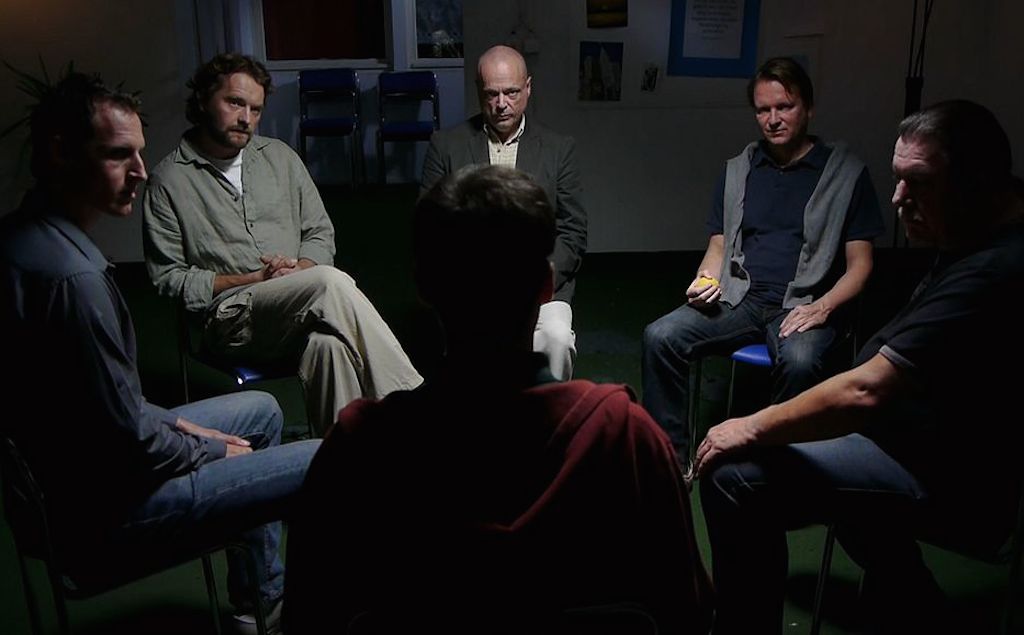Helping Abusers Change Their Lives
Experts say abusive behavior isn't inherent but is culturally learned and therefore can be unlearned. Philipp Müller-Dorn / Wikimedia Commons
Philipp Müller-Dorn / Wikimedia Commons
It’s hard to view domestic violence abusers objectively. Our collective lens is clouded by the horrific behavior these men inflict on their victims. People tend to believe that perpetrators can’t change how they think and act, so why try?
Those beliefs are false, according to many survivors and others involved with cases of domestic violence. Experts say abusive behavior isn’t inherent but is culturally learned and therefore can be unlearned. And they say it’s essential to offer abusers help for the safety of the women and children involved.
“We’ll continue going in circles if we don’t give abusers the education—the chance to change,” says Kristen Paruginog, who was raised by a father who abused her mother, lived with an abusive boyfriend and went on to found a domestic violence educational organization in San Diego.
Men who abuse often grow up in a culture of abuse, according to Scott Miller of the Duluth Model, a system of domestic abuse intervention programs based in Duluth, Minn. “They learn a bias that they’re better than women,” he says. “They believe they have a privilege … that men can run the household. Every community across the globe has batterers like this.”
Many of these men were victimized themselves during childhood. “My dad was abused,” Paruginog says. “There’s no excuse for abuse, but going back generations, my family has had abuse. I absolutely understand my dad, but it took me 23 years to want to forgive him.”
One widespread misconception is that anger alone triggers abuse. “What may look like anger actually may be an attempt to decrease another person’s value,” says Janet McKee, a Central Oregon therapist with extensive experience in helping people change abusive behavior. “Someone who has learned domestic violence as a path toward power may act as if it is anger that they can’t control, when they are very much in control.”
TerryJosiah Sharpe is a songwriter in San Diego who met Paruginog when his brother urged him to create a song for her organization, Break the Silence Against Domestic Violence. As he talked with her and later took an online class, he realized he was abusive himself, although he didn’t actually engage in violence.
“My type of abuse was more emotional and psychological,” Sharpe says. “I had to be the all-powerful man. I thought it was necessary for the man to put his foot down. The lady needed to do what he said when he said it. I didn’t realize I was abusive, because I never hit a woman. I felt I was better than abusers. I said, ‘I’m not hitting you, so everything is OK.’ ”
Most abusers can change their beliefs about power and control and learn new behaviors, Miller says. First, these men need motivation to change.
Paruginog says her father tried various methods to change his behavior, including therapy, but he finally was motivated to stop abusing her mother for a very personal reason: seeing his daughter enter an abusive relationship of her own. “It changed his perspective,” she says. “Dad had to make those decisions on his own. No one else could do it.”
Even before he realized his behavior was abusive, Sharpe was motivated to change because he didn’t want to jeopardize his relationship with his children.
“I said to myself, ‘Hey buddy, what are you doing?’ ” Sharpe says. “I started to understand the types of relationship I had with my kids’ moms. Ten years down the line, I didn’t want to have a terrible relationship—or no relationship—with my kids because I was arguing with their moms.”
Sharpe had grown up in a household where yelling and emotional abuse were the norm. “I don’t believe I wanted unhealthy relationships, but that was all I knew,” he says. “I didn’t want to be mad or yell, but it was second nature for me.”
Sharpe began to make conscious changes to build healthier relationships. “Now I process everything,” he says. “I don’t allow myself to get to a level that I don’t know what I’m saying. I realize I need to focus on [my emotions and] what I say. Words are powerful. … You can still have disagreements, but that doesn’t mean I’m going to slander you or say ugly things. Before, it was fairly easy for that language to come out.”
As a musician, Sharpe is especially aware of the effect song lyrics have on people. “Be cautious of what you listen to—it plays a factor in your life,” he says. “If you listen to violent lyrics, your language can be violent even if you’re not a violent person. Our language affects everything we do in life—we’re always learning or teaching. If we listen to music that’s degrading or violent, we’re learning that subconsciously.”
Sharpe shares these lessons with his children. “My kids and I do daily affirmations about worth,” he says. One affirmation states: “There is power in my words. I am powerful, but with that power comes responsibility. There is power in my words, so I must watch what I say at all times. I speak with love and live in peace. I love you, I love me, and I love we.”
The learning process is ongoing. “I am doing my best to break the cycle of abuse,” Sharpe says. “There are hard habits to break. They [the children] are still learning. I’m still learning. We’re definitely doing our best to make sure the cycle of abuse ended with the generation before me.”
Many other men are motivated by outside forces—for instance, a court orders them to get help, or they risk losing their partners. In these cases, “Virtually none want to change initially,” Miller says. “At first, they feel they’re the victims.”
But with the right kind of intervention, an abuser’s motivation to change can be sustained and internalized, according to Etiony Aldarondo, a researcher and writer for the online publication Juvenile and Family Justice Today. Aldarondo says that a successful intervention must be multifaceted, requiring men to accept responsibility for their past behavior, gain empathy for their partners and develop new, nonabusive skills to resolve conflicts.
Programs that can help with this often take the form of group educational interventions, or group counseling, which is often court-ordered. The group dynamic is very effective, according to McKee, who has facilitated such programs with adults and teens.
“It’s helpful to realize that behind the façade any person may give to the world about being ‘fine, confident, coping, have-it-all, tough, cocky, nothing-bothers-me’ is a real-life person with vulnerable feelings and struggles,” McKee says. “Group members consistently come to empathize with each other and to recognize … they have many things in common and that differences can actually be appreciated, versus [being] disrespected or dishonored.”
Rob and Marie (pseudonyms) are now a married couple with a healthy relationship, but during their engagement years ago, Rob physically assaulted Marie. She refused to stay with him unless he got help, and he valued their relationship so much that he entered a men’s group.
Speaking from their home in Oregon, Marie says, “The thing that struck me most about the group was that Rob wasn’t alone anymore. He saw there are lots of people who have a hard time with anger. He learned about the ongoing effects of early childhood abuse and how that manifests in adults.”
Rob credits the group with teaching him nonviolent communication techniques. He says that before attending the group, “I didn’t have a way to express my feelings without getting upset. I learned much more about expressing feelings.
“You learn a whole vocabulary of feelings. Sometimes when we think we’re expressing feelings, they’re not true feelings—they’re justification. Like feeling betrayed—we identify it as a feeling to justify certain behaviors. But feelings are usually more basic, like fear or joy. If you have trouble describing (true) feelings, you get a cheat sheet that helps you identify them. Just to identify your feelings does a lot to defuse anger.”
Marie adds: “One of the things he learned about is a process called emotional flooding [when a trigger causes an overwhelming emotion, such as rage or panic, that cuts off access to rational thought]. Rob began to be able to verbalize that. He could say, ‘I’m flooding.’ ”
When Marie heard Rob identify that feeling, she was willing to stop and change the way an interaction was going. “If a couple wants to continue after a violent episode, it takes both of them,” she says. “It’s not an excuse [for violent behavior], but there’s an interaction. You don’t want to get into the position of ‘If I had been a better wife, he wouldn’t have exploded.’ But if you want to rebuild the relationship, you both have to be actively involved.”
Group participants also engage in exercises they can use in outside relationships, McKee says. “They use ‘I’ statements to take responsibility for their own feelings and actions. They use affirmations of themselves and others—for example, ‘I think we both want to solve this [or] get our needs met.’ They role-play real-life conflict situations and ‘doing it differently.’ ”
Miller of the Duluth Model says group interventions also are successful because they mix newcomers with men who have been in a group for weeks or months. “[Men who have been there] 20 weeks see there’s something in it and that they can live a new life,” he says. “New guys see that. When we ask guys what’s been most helpful, they say ‘hearing other men’s stories.’ ”
Rob agrees that adding new men to a group is beneficial to all involved. “Each time a new member would start, we would hear their story and we would retell our story about how we got there,” he says. “It was a great way to build compassion.”
Group interventions vary in their specifics. In the Duluth Model, which is designed to be replicated nationally and internationally, programs are part of coordinated, systemwide efforts to change the way abusers are treated. These practices start with the 911 response team and extend to police, probation officers and facilitators of men’s counseling groups. Miller says the entire effort requires a lot of work, but improved recidivism rates convince involved parties to continue their efforts.
Within Duluth Model groups, men are guided through an activity called “logging” to help them think critically about what they’ve done. Sessions deal with such issues as emotional abuse. Miller says a group facilitator might start by saying, “Let’s think about the things you’ve done that have been emotionally abusive. What was your intent? What did you want to happen?”
The crux is what the men believe, Miller says—for instance, that they have the right to inflict emotional abuse on their partners. But as they participate in the group, they begin to see the effect their actions have on them, their partners and their children. “They see their lives reflected back on them,” Miller says. “They used to think, ‘I called her a bitch—who cares?’ But [then] they start to think, ‘I don’t want this.’ ”
Like the Duluth Model, the Alma Center in Milwaukee is committed to ending abuse by men and improving the safety of women and children. Its intervention groups have a different focus, according to Casey Corcoran of Futures Without Violence, a nonprofit that works with a variety of organizations to end domestic violence.
Alma Center groups “help men understand their own trauma and how it influences their behavior,” Corcoran says. “They use a trauma lens. It’s not to make excuses but to get to the root of the problem.”
These groups utilize innovative approaches, such as healing circles that combine therapeutic techniques and new findings in neurology with indigenous healing practices. Other Alma Center groups concentrate on topics such as developing fathering and co-parenting skills.
Steps to change—such as becoming accountable for one’s behavior—don’t come easily. “I had to admit I was an abuser,” Sharpe recalls. “That was one of the hardest things I’ve ever done.” Taking that hard step turned out to be transformational in several ways. Sharpe is now in a healthy personal relationship with Paruginog, and he helps with educational efforts for Break the Silence.
Many men have to repeat intervention programs before they achieve success. Critics, and even program advocates, say some men will never be successful—usually those who suffered extreme violence or sexual abuse when they were children. Another population that may not be able to change includes those with mental health issues that prevent them from empathizing or following linear conversations.
Completing a class doesn’t guarantee a fairy-tale ending for an abuser. For instance, their partners may not want to reunite with them. Myrna (a pseudonym), who lives in Southern California, is a case in point. Her abuser “really physically and mentally messed me up for a long time,” she says. “While he was in prison, he took a lot of anger management classes and a lot of self-help classes. I hope he has changed … I don’t know whether those classes improved him, but I’m not going to find out.”
In other cases, a group intervention makes a long-lasting, positive difference for a couple. “[The men’s group] created a lot of changes in both of us,” Marie says. “We wouldn’t have stayed together without it.”
She adds, “We never deny the reality of [Rob’s violent behavior]. We don’t dismiss it or reduce the importance of it. The strength of it is that with this group as part of our history, we’ve been able to rebuild and keep rebuilding.”
On a societal level, one measure of success can be determined by tracking recidivism. This technique is limited, because not all violence is reported, but statistics can indicate progress. In Duluth, for example, 68 percent of offenders who attend nonviolence classes and benefit from coordinated criminal justice programs don’t show up in the system for the next eight years. Other communities that have adopted parts of the Duluth Model also have reported substantial reductions in recidivism.
Other research points to intervention programs that result in little or no progress. However, these findings may be suspect because many programs “subsist on shoestring budgets … with only part-time staff,” according to “Batterer Intervention,” a report co-sponsored by the Family Violence Prevention Fund. The report goes on: “Some practitioners think it is unfair to hold … efficacy to very high standards when most programs have not had a chance to reach their potential as fully funded enterprises.”
Miller points out a significant reason for offering help to male abusers—one that doesn’t have to do with statistics. “We have a men’s program because [at the onset], women survivors said it makes them safer,” he says. “One man was kicked out of our programs three times but was successful a fourth time. The man said, ‘I have to appreciate this program. You still accepted me back.’ I told him, ‘The number one reason we accepted you back was because of the woman you’ll be with next. You’re number two.’ ”
Your support matters…Independent journalism is under threat and overshadowed by heavily funded mainstream media.
You can help level the playing field. Become a member.
Your tax-deductible contribution keeps us digging beneath the headlines to give you thought-provoking, investigative reporting and analysis that unearths what's really happening- without compromise.
Give today to support our courageous, independent journalists.



You need to be a supporter to comment.
There are currently no responses to this article.
Be the first to respond.